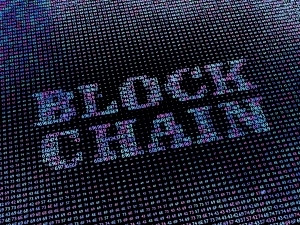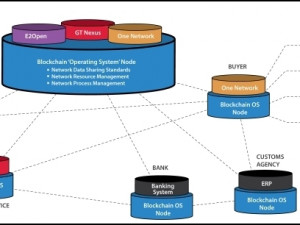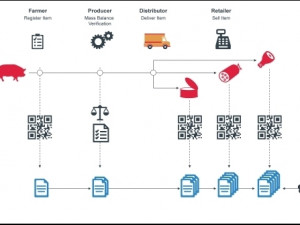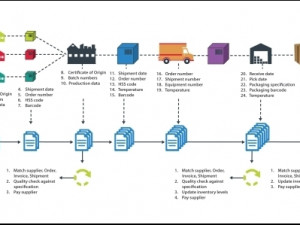
This is the second of a two-part series examining the impact of blockchain technology on supply chains.
In part I, I examined how blockchains work, and the potential game-changing impact of this new technology on supply chains as a record-keeping, verification, tracking and transaction switching mechanism that makes it easier and safer for businesses to work together over the Internet, says Jan van Rooyen, Strategic Solutions Lead at Resolve.
Every time value changes hands, whether physical products, services or money, the transaction can be documented, creating a permanent history of the product or transaction, from source to ultimate destination.
Some supply chains are already exploiting this technology, and experts suggest blockchain could become a universal "supply chain operating system" - fundamentally changing the way the following tasks are performed and supply chain systems are built:
* Assigning or verifying certain properties of products, and sharing information about the source or manufacturing process of a product throughout its journey to the point of sale or consumption.
* Tracking and automated matching of the cascade of digitised documents involved in any trade: purchase orders, invoices, receipts, shipment orders and manifests, and other trade-related documents such as bills of lading.
* Recording the quantity and transfer of supply chain assets: pallets, delivery and handling units and containers, as they move between supply chain nodes.
* Providing a decentralised and secure tokenised system to link physical goods to serial numbers, bar codes, RFID tags, etc.

Let's now look at evidence for the above in a few real-world applications of blockchain:
Traceability within food supply chains
In October 2016, Walmart launched its Food Safety Collaboration Centre, in Beijing, with the goal to improve the way food is tracked, transported and sold to consumers across China. It will harness IBM Blockchain technology to generate transparency and efficiency in supply chain record-keeping.
The first food item to be tracked this way is pork. Information such as farm origination details, batch numbers, factory and processing data, expiration dates, storage temperatures and shipping detail are digitally linked to the physical food items as it moves from source to destination.
The information captured during each transaction is validated by businesses within the network (farms, transport companies, packaging companies, warehouses and stores) forming a consensus. After each 'block' (record of each transaction) is validated, it is added to a 'chain' of transactions, becoming a permanent record of the entire process.
Each pork item received at store is verified as authentic, and its digital record could potentially reveal food safety issues picked up between farm and store. The digital record can also help Walmart retailers better manage the shelf-life of products in individual stores.

Healthcare service supply chains
While pharmaceutical supply chains will benefit from blockchain in a similar fashion as the food supply chain, it is healthcare's services supply chain (patients, healthcare workers, laboratories, dispensing points and pharmaceutical suppliers) that stands to benefit more.
The Bill and Melinda Gates Foundation recently awarded a grant to Factom, a blockchain technology firm, to fund the creation of an electronic health records system that provides immutability and security in an affordable manner.
Medical records within developing countries are historically documented on paper and stored by clinics or hospitals. This poses a problem when people move or if the region is destabilised.
Factom's blockchain network digitises, stores, and encrypt a patient's medical record in a decentralised manner. Access to these records would not be dependent on a strong Internet connection to a central server or database, since the data would be distributed across various nodes of the blockchain network.
Healthcare service providers and patients can access and share documents such as vaccination records and HIV viral load measurements on their phones, to ensure they are providing the correct treatment to the right patient. Biometric verification is used for an added layer of security.
Patient data is collected into a single 'hash' and then added to the blockchain. With medical records, the hash would serve as a fingerprint of the data for time-stamping and verification purposes. Patients' health records secured like this do not contravene the privacy provisions of most privacy and information laws and acts.
This blockchain function allows for the de-identification of protected information by one-way conversion to hash values (an encrypted string of data), safeguarding the content of sensitive records being revealed to third parties, and allowing the records themselves to remain at their original digital location.
Supply chain and trade finance
Barclays Africa, Bank of America and HSBC have similarly used blockchain trade platforms to facilitate the transfer of trade documents for their clients.
The pilot trade, in the process of being commercialised during 2017, involved a letter of credit transaction between a diary distributor in Seychelles and Ornua (formerly the Irish Dairy Board), clients of Barclays Africa and Barclays UK respectively. It used a blockchain technology platform to transfer the electronic bill of lading, with the payment made through the Society for Worldwide Interbank Financial Telecommunication (SWIFT).
A blockchain application allows all stakeholders in the supply chain to send, receive and track an electronic bill of lading, as well as upload and send related trade documentation such as orders, invoices, permits and shipping instructions. The application is linked to a distributed ledger network which securely records and verifies the ownership and authenticity of the documents.
This solution eliminates many of the current inefficiencies in international trade - the Global Alliance for Trade Facilitation estimates that "7% of the global value of trade is absorbed by the cost of documents alone". It also reduces risks such as fraud, prevents forgeries of documents, and importantly it saves time by reducing system and process latency - typically trade documents take anywhere from two to 10 working days to be couriered from party to party. Now it can be done electronically in minutes.
Automotive company Mahindra is experimenting with blockchain to run its invoice discounting business. Invoice discounting is the process of bundling and selling unpaid bills at a slight discount and is a major source of working capital for suppliers who would otherwise need to wait a month or more to be paid.
The invoice discounting process would normally take as much as seven days to complete between Mahindra and its supply chain finance partners. There are a number of manual interventions and often there are disputes because different systems' records do not show the same information. Within a blockchain network there is a 'single point of truth', which makes the pricing decision less risky and the administration process more efficient - now taking minutes instead of days.
Shipment information verification
The first public blockchain solution for the shipping industry was deployed by Marine Transport International (MTI), a UK and USA-based freight forwarder, using blockchain technology for sharing Verified Gross Mass (VGM) information of shipping containers.
Contracting governments to the International Maritime Organization's SOLAS treaty (International Convention for the Safety of Life at Sea) are required to implement new requirements related to the VGM of packed containers. The new regulation puts the responsibility on the shipper to ensure that an accurate VGM is provided to the port terminal and ocean carrier for every container loaded prior to it being allowed to be shipped on-board on a vessel.
Knowledge about a container's VGM is important to make sure that vessels are stowed correctly in order to prevent accidents both at sea and in ports.
VGM data is stored on a public blockchain, providing a permanent records visible to port officials, transport companies, shippers and cargo owners. This replaces cumbersome logs, spreadsheets, data intermediaries and private databases.
Supply chain management
A distributed ledger system, which makes it easy for participants to track the ownership of an asset, could be applied to track automotive parts as they move between countries and factories. This is the premise of Toyota's venture into a blockchain solutions for their core parts supply chain operations.
Keeping accurate records, in real-time, of the thousands of parts that go into building a car would make Toyota more efficient, and could also help during supply chain disruptions.
Short mention of various other practical supply chain management applications for blockchain are made below:
* International clients may require certification of origin documents, best created, validated, and secured with blockchain's notarisation characteristics. Change of ownership midway through a shipment, called Merchanting, is made possible, as well as the possibility to trace back the origin of all components of a finished item's bills of material.
* The use of third party logistics service providers (3PLs), ocean carriers, and freight forwarders can be regulated and automatically controlled by irrevocable and immutable smart contract execution.

* Goods returned for repairs or refurbishment are managed within strict processes to ensure that repairs follow strict protocols, and once refurbished, the products are again compliant with specifications and criteria that blockchain's notarisation efficiently can resolve.
* Goods moving within a return logistics process may also be subject to warranty clauses that require changing the title of possession. Similarly, malfunctioning goods could be traced all the way back to the origin of components, to perform a root-cause analysis and identify the source of defect.
It is thus clear that the flows of warranties, goods for repairs, and associated costs and specifications can be controlled via smart contracts, and the irrevocability of the transactions throughout the product's life cycle together with the possibility to access valid and notarized documents make blockchain a very good fit for this type of supply chain activities.
In summary
There are a multitude more examples of how blockchain is starting to impact all kinds of supply chains and related activities. Regardless of the application, blockchain offers industry the following advantages:
* Increase supply chain speed - electronic contracts that automate the transfer of ownership of the goods and authorise the release of payments. Because the money will move faster, supply chains will move faster.
* Increase supply chain security and visibility - security and visibility are often perceived as opposing forces, the one curtailed by the other. The reasons for this are:
* It is distributed in nature. There is no master computer or platform holding the entire chain. Each participating node have a copy of the chain.
* When someone wants to add a transaction to the chain, the majority of participants in the network will have to validate it.
* Everyone participating in a blockchain network, whether permissioned/private or permissionless/public, can see the blocks and the transactions stored in them. This doesn't mean everyone can see the actual content of the transactions - that is protected by each participant's private key.
* The database can only be extended and previous records cannot be changed.
* Increase supply chain integration - blockchain takes digitisation of the supply chain to an altogether much higher level. Digitisation exponentially increase the potential for integration and convergence of technologies and systems. This makes blockchain the ideal candidate for a "supply chain operating system".
* Greater scalability - with no master computer or platform holding the entire chain, as is the case with current supply chain management platforms and enterprise resource planning systems, a blockchain network can scale with the Internet.
Share